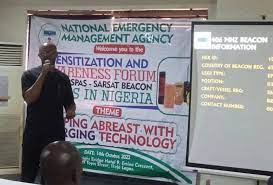The National Emergency Management Agency (NEMA) has urged all aircraft and ship owners to apply full safety measures in their operations.
The agency made the appeal at a one-day awareness and sensitisation workshop aimed at reiterating the importance of continuous safety consciousness on Sunday in Lagos.
The Director, Search and Rescue, NEMA, Air Commodore Edwards Adedokun, who declared the workshop open, said critical stakeholders in maritime, aviation, response agencies and regulators in the various sectors were invited to attend the workshop.
Adedokun, who was represented by Mr Ibrahim Farinloye, the Coordinator, Lagos Territorial Office of the agency, called on participants to take the opportunity of the workshop to acquire new safety tips.
He said there was need for them to be conscious of safety in their sectors, adding that any wrong step could spell doom for their operations.
The director cited the crash of Quorum Helicopters in Lagos and Kaduna States, where their alert equipment malfunctioned.
He added that if such had happened in a thick forest, tracking location with the malfunctioning beacons would not have been easy.
Adedokun explained that COSPAS and SARSAT were high-tech satellite-based equipment, positioned in the orbit to track distressed alert emitted by the bearing of beacons installed in the aircraft, ships or by individual.
According to him, the equipment are based in NEMA headquarters which covers West and Central African countries, to track distress alerts from any source that needs protection, evacuation and assistance as the case may be.
“This year alone, the Mission Control Centre, situated in Abuja, has recorded 130 resolved distressed alerts which turned out to be false.
“There are three types of alerts, Initial Alert, Resolved Alert and Update alert,” he explained.
Adedokun said, “lnitial alert is when 406 mhz beacon sends distressed alert and is picked up by COSPAS SARSAT, the resolution commences with downloading details of the owners.“
“It also involves contacting the owners to enquire about the situation of the equipment where actual situation is not given.
“Then, coordinate of the location of the aircraft, ship or individual will be established, which will be despatched to all emergency response and regulatory agencies for action.
“While resolved alert indicates that upon its reception, it was established that the owners were just making maintenance checks.“
Adedokun added that the 130 recorded cases were not actual distress alert, but classified as false.
“This is to say that the 130 resolved alerts are false but the initial and update alerts are not counted.
“The coordinates will indicate the scene with 40 square metres for ease of response,” he said.
He, however, appealed to the aircraft operators, both private and commercial as well as ship owners to procure, install and ensure regular maintenance checks on their equipment as required.








Obrigado|Olá a todos, os conteúdos existentes nesta
Can you be more specific about the content of your article? After reading it, I still have some doubts. Hope you can help me.
I view something genuinely special in this internet site.
Can you be more specific about the content of your article? After reading it, I still have some doubts. Hope you can help me.
Your positivity and enthusiasm are infectious I can’t help but feel uplifted and motivated after reading your posts
Howdy! I just want to give you a huge thumbs up for your excellent info you have here on this post. I will be coming back to your blog for more soon.
Znáte nějaké metody, které by pomohly omezit krádeže obsahu? Rozhodně bych ocenil
I like this weblog so much, bookmarked. “To hold a pen is to be at war.” by Francois Marie Arouet Voltaire.
The Maltese lira was replaced by the euro because the official currency of Malta on the irrevocable fixed change price of Lm 0.429300 per €1.
Your article helped me a lot, is there any more related content? Thanks!
Hello there! This is kind of off topic but I need some help from an established blog. Is it very hard to set up your own blog? I’m not very techincal but I can figure things out pretty quick. I’m thinking about setting up my own but I’m not sure where to start. Do you have any points or suggestions? Thanks
Wow! This blog looks exactly like my old one! It’s on a totally different subject but it has pretty much the same layout and design. Excellent choice of colors!
Your point of view caught my eye and was very interesting. Thanks. I have a question for you.
Introducing to you the most prestigious online entertainment address today. Visit now to experience now!
Really fantastic information can be found on web site.
What i do not understood is in truth how you are not actually a lot more smartlyliked than you may be now You are very intelligent You realize therefore significantly in the case of this topic produced me individually imagine it from numerous numerous angles Its like men and women dont seem to be fascinated until it is one thing to do with Woman gaga Your own stuffs nice All the time care for it up
Good day! This is my first visit to your blog! We are a team of volunteers and starting a new project in a community in the same niche. Your blog provided us valuable information to work on. You have done a marvellous job!
None of this a hundred hours to finish the game and get your reward stuff.
窓口両替は20枚まで無料。 しかし、ゆうちょ銀行の発足によって競争が激化されていることなどから、両行とも店舗外ATMの維持管理などにおける経費の削減を実施することとなり、2008年5月12日に各行がそれぞれ設置されている店舗外ATMのうち、主に官公庁や病院等などにそれぞれ、各行6カ所ずつを共同ATM化として移行された。 また、北海道旭川市にも旭川支店が開設されていたが、1980年代中期頃に廃止された。北海道、東北のごく一部の店舗ではうどん屋「できたて厨房」が併設されている。弟子に対しては厳しいが、反面、素直に耳を傾ける優しさもある。
Thank you for your sharing. I am worried that I lack creative ideas. It is your article that makes me full of hope. Thank you. But, I have a question, can you help me?
『’98時代』は「フジテレビ開局40周年記念番組」として制作された。同年終わりに「Future Nostalgia」というタトゥーを左腕に彫ったことを発表し、同名タイトルの2ndアルバムのリリースが近いことをアナウンスするも、新型コロナウイルス感染症(COVID-19)のパンデミックが襲来してしまう。 さらに、同年リリースされたカルヴィン・ さらに、3つの収録曲も同時に全英トップ10入りを果たし、”英国人女性アーティスト史上最も1日でストリーミング再生されたアルバム”という快挙を成し遂げる。 アワード(Brit Awards)」において女性アーティスト史上初の5部門でノミネートされ、最優秀ブリティッシュ女性ソロ・
Můžete mi doporučit nějaké další blogy / webové stránky / fóra, které se zabývají stejnými tématy?
I wanted to thank you for this excellent read!! I absolutely loved every little bit of it. I have you saved as a favorite to check out new stuff you post…
I seriously love your website.. Very nice colors & theme. Did you make this site yourself? Please reply back as I’m trying to create my own personal blog and would love to find out where you got this from or exactly what the theme is called. Cheers!
I don’t think the title of your article matches the content lol. Just kidding, mainly because I had some doubts after reading the article.
We are a gaggle of volunteers and opening a new scheme in our community.Your website provided us with valuable info to work on. You have performed a formidablejob and our whole group might be grateful to you.
Hello! I know this is kinda off topic but I was wondering which blog platform are you using for this website? I’m getting sick and tired of WordPress because I’ve had problems with hackers and I’m looking at options for another platform. I would be great if you could point me in the direction of a good platform.
CICIJITU adalah platform layanan toto macau terbaik asal indonesia yang telah banyak diminati masyarakat sekitar
Thanks for sharing. I read many of your blog posts, cool, your blog is very good.
Your article helped me a lot, is there any more related content? Thanks!